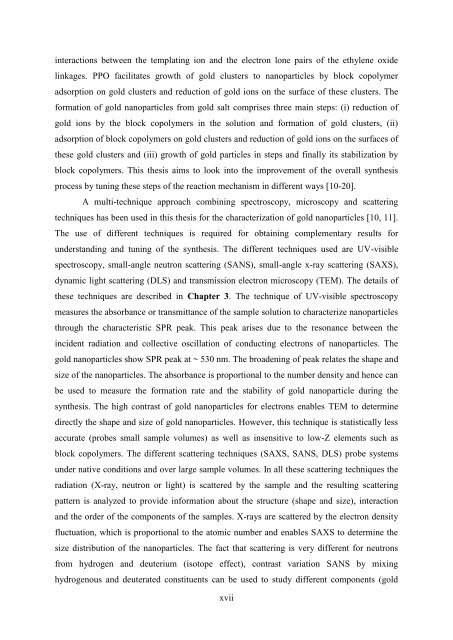PHYS01200704032 Debes Ray - Homi Bhabha National Institute
PHYS01200704032 Debes Ray - Homi Bhabha National Institute
PHYS01200704032 Debes Ray - Homi Bhabha National Institute
Create successful ePaper yourself
Turn your PDF publications into a flip-book with our unique Google optimized e-Paper software.
interactions between the templating ion and the electron lone pairs of the ethylene oxide<br />
linkages. PPO facilitates growth of gold clusters to nanoparticles by block copolymer<br />
adsorption on gold clusters and reduction of gold ions on the surface of these clusters. The<br />
formation of gold nanoparticles from gold salt comprises three main steps: (i) reduction of<br />
gold ions by the block copolymers in the solution and formation of gold clusters, (ii)<br />
adsorption of block copolymers on gold clusters and reduction of gold ions on the surfaces of<br />
these gold clusters and (iii) growth of gold particles in steps and finally its stabilization by<br />
block copolymers. This thesis aims to look into the improvement of the overall synthesis<br />
process by tuning these steps of the reaction mechanism in different ways [10-20].<br />
A multi-technique approach combining spectroscopy, microscopy and scattering<br />
techniques has been used in this thesis for the characterization of gold nanoparticles [10, 11].<br />
The use of different techniques is required for obtaining complementary results for<br />
understanding and tuning of the synthesis. The different techniques used are UV-visible<br />
spectroscopy, small-angle neutron scattering (SANS), small-angle x-ray scattering (SAXS),<br />
dynamic light scattering (DLS) and transmission electron microscopy (TEM). The details of<br />
these techniques are described in Chapter 3. The technique of UV-visible spectroscopy<br />
measures the absorbance or transmittance of the sample solution to characterize nanoparticles<br />
through the characteristic SPR peak. This peak arises due to the resonance between the<br />
incident radiation and collective oscillation of conducting electrons of nanoparticles. The<br />
gold nanoparticles show SPR peak at ~ 530 nm. The broadening of peak relates the shape and<br />
size of the nanoparticles. The absorbance is proportional to the number density and hence can<br />
be used to measure the formation rate and the stability of gold nanoparticle during the<br />
synthesis. The high contrast of gold nanoparticles for electrons enables TEM to determine<br />
directly the shape and size of gold nanoparticles. However, this technique is statistically less<br />
accurate (probes small sample volumes) as well as insensitive to low-Z elements such as<br />
block copolymers. The different scattering techniques (SAXS, SANS, DLS) probe systems<br />
under native conditions and over large sample volumes. In all these scattering techniques the<br />
radiation (X-ray, neutron or light) is scattered by the sample and the resulting scattering<br />
pattern is analyzed to provide information about the structure (shape and size), interaction<br />
and the order of the components of the samples. X-rays are scattered by the electron density<br />
fluctuation, which is proportional to the atomic number and enables SAXS to determine the<br />
size distribution of the nanoparticles. The fact that scattering is very different for neutrons<br />
from hydrogen and deuterium (isotope effect), contrast variation SANS by mixing<br />
hydrogenous and deuterated constituents can be used to study different components (gold<br />
xvii

















